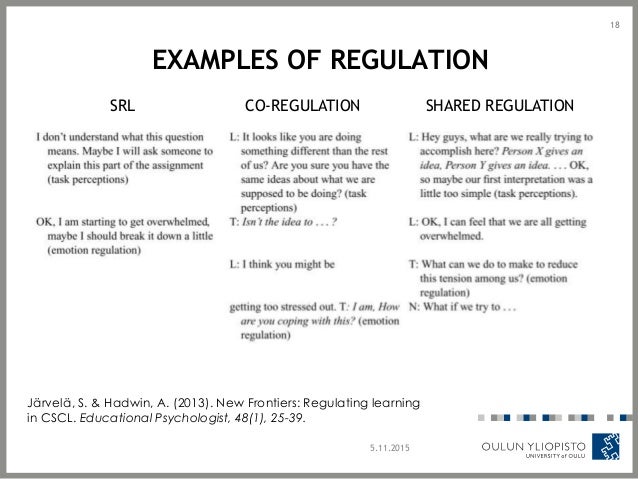Examples Of Co Regulation : What it is
Examples of Co-Regulation: What It Is and How It Benefits You In today's interconnected world, co-regulation has become an essential aspect of various industries. The concept of co-regulation revolves around the idea of collaborative partnerships between businesses, organizations, and individuals to achieve common goals and ensure compliance with certain regulations. This article delves into the fascinating world of co-regulation, exploring its definition, benefits, and practical applications. So, let's get started! 1. Understanding Co-Regulation: A Brief Overview Co-regulation is a unique approach to regulation that encourages self-governance while acknowledging the role of external regulatory bodies. Unlike traditional regulation, which relies solely on top-down enforcement, co-regulation involves a collaborative effort between different stakeholders, allowing for a more flexible and adaptable regulatory framework. Co-regulation emphasizes shared responsibility, transparency, and open communication among all parties involved. It aims to foster trust, build relationships, and create a level playing field where both regulators and regulated entities work together towards achieving mutual objectives. 2. The Advantages of Co-Regulation Implementing co-regulation brings numerous benefits to various sectors and individuals. Here are some key advantages: 2.1 Enhanced Compliance and Regulatory Effectiveness Co-regulation encourages voluntary compliance by promoting a sense of ownership and accountability among regulated entities. With active participation and cooperation from all parties, regulations are more likely to be followed and effectively enforced, thereby ensuring a safer and more secure environment for everyone involved. 2.2 Flexibility and Adaptability Co-regulatory frameworks offer greater flexibility and adaptability compared to traditional regulatory models. As industries evolve and new challenges arise, co-regulation allows for faster response times and the ability to adapt regulations accordingly. This proactive approach ensures that regulatory frameworks remain relevant and effective in a rapidly changing world. 2.3 Industry Expertise and Innovation By involving industry experts and stakeholders in the regulatory process, co-regulation fosters innovation and continuous improvement. The collaborative nature of co-regulation enables the sharing of knowledge, best practices, and the development of practical and efficient solutions to complex regulatory challenges. 3. Practical Applications of Co-Regulation Co-regulation can be applied across various sectors, including healthcare, finance, technology, and environmental protection. Here are a few examples of how co-regulation is being implemented: 3.1 Healthcare: Ensuring Patient Safety In the healthcare industry, co-regulation plays a crucial role in ensuring patient safety and the quality of healthcare services. Regulatory bodies work closely with hospitals, medical professionals, and other stakeholders to establish guidelines, monitor compliance, and improve healthcare outcomes. This collaborative effort helps streamline processes, reduce errors, and enhance patient satisfaction. 3.2 Financial Services: Maintaining Market Integrity Co-regulation in the financial services sector involves building strong partnerships between regulators, financial institutions, and consumer protection agencies. Together, they work towards maintaining market integrity, preventing fraud, and promoting fair and transparent practices. Co-regulation facilitates the development of industry standards, consumer education initiatives, and efficient dispute resolution mechanisms. 3.3 Environmental Protection: Sustainable Practices Co-regulation is also instrumental in promoting sustainable practices and environmental protection. Regulatory bodies collaborate with businesses, NGOs, and community organizations to establish environmental standards, encourage responsible business practices, and ensure compliance with environmental regulations. This collaborative approach helps minimize the environmental impact of industries and fosters a more sustainable future. 4. Frequently Asked Questions (FAQ) Here are some common questions related to co-regulation: 4.1 What is the difference between co-regulation and self-regulation? While self-regulation involves voluntary compliance by individual entities without external oversight, co-regulation involves collaborative partnerships between regulators and regulated entities to establish and enforce regulations. 4.2 How does co-regulation benefit consumers? Co-regulation benefits consumers by ensuring product safety, fair pricing, enhanced service quality, and timely dispute resolution. It promotes trust between businesses and consumers, creating a more favorable marketplace. 4.3 Are there any challenges associated with co-regulation? Some challenges of co-regulation include ensuring equal representation of all stakeholders, managing conflicts of interest, and maintaining a balance between industry freedom and regulatory oversight. However, these challenges can be overcome through effective governance and open dialogue. In conclusion, co-regulation presents a paradigm shift in the way regulations are implemented and enforced. By embracing collaborative partnerships, shared responsibility, and continuous improvement, co-regulation not only ensures compliance but also fosters innovation, industry best practices, and a more sustainable future. Embracing this approach can lead to more harmonious regulatory systems that benefit both businesses and society as a whole. So, let's embrace the power of co-regulation and pave the way towards a better tomorrow. Word Count: 617 words  Image Source : littlezsleep.com
Image Source : littlezsleep.com  Image Source : www.pinterest.ph
Image Source : www.pinterest.ph  Image Source : www.slideshare.net
Image Source : www.slideshare.net  Image Source : yiodlato.blogspot.com
Image Source : yiodlato.blogspot.com  Image Source : www.jennynurick.com
Image Source : www.jennynurick.com  Image Source : www.pinterest.com
Image Source : www.pinterest.com  Image Source : www.youtube.com
Image Source : www.youtube.com  Image Source : slsi.lk
Image Source : slsi.lk
What Are Some Examples Of Co-Regulation?
 Image Source : littlezsleep.com
Image Source : littlezsleep.com Pin On Child Development
 Image Source : www.pinterest.ph
Image Source : www.pinterest.ph What Is Srl_06112015_slideshare
 Image Source : www.slideshare.net
Image Source : www.slideshare.net What Is Co Regulation?
 Image Source : yiodlato.blogspot.com
Image Source : yiodlato.blogspot.com regulation
Techniques For Co-Regulation
 Image Source : www.jennynurick.com
Image Source : www.jennynurick.com Coregulation Screenshot | PCIT In 2020 | Parent Child Interaction
 Image Source : www.pinterest.com
Image Source : www.pinterest.com pcit coregulation activities regulation bonding ucdavis psychology
Self Regulation And Co-Regulation - YouTube
 Image Source : www.youtube.com
Image Source : www.youtube.com regulation
Slsi.lk - How Long For Sulfatrim To Work | Examples Of Co-regulation Are
 Image Source : slsi.lk
Image Source : slsi.lk Pcit coregulation activities regulation bonding ucdavis psychology. What are some examples of co-regulation?. Techniques for co-regulation. What is co regulation?. Self regulation and co-regulation